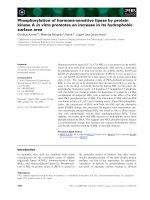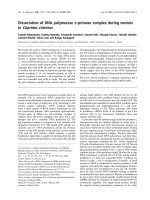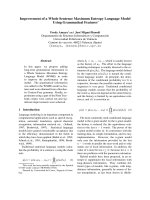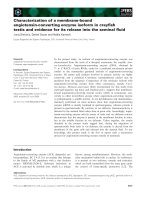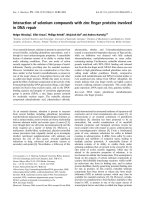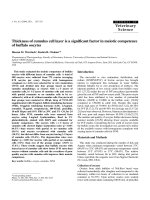Báo cáo khoa học: "Performance of different provenances and of the local population of the Monterey pine (Pinus radiata D Don) in northern Spain" pot
Bạn đang xem bản rút gọn của tài liệu. Xem và tải ngay bản đầy đủ của tài liệu tại đây (283.62 KB, 5 trang )
Note
Performance
of
different
provenances
and
of
the
local
population
of
the
Monterey
pine
(Pinus
radiata
D
Don)
in
northern
Spain
S
Espinel,
A Aragonés
E
Ritter
CIMA,
Apartado
46, 01080
Vitoria-Gasteiz,
Spain
(Received
22
February
1994;
accepted
13
April
1995)
Summary —
The
performances
of
3
Pinus
radiata
provenances,
composed
of
different
subprove-
nances,
and
of
the
local
population
were
compared
in
a
completely
randomized
design
in
a
4-year
trial
at
Onyi
Mountain
(Basque
country,
northern
Spain).
Significant
differences
between
populations
were
observed
for
the
growth
characteristics.
The
Monterey
population
showed
the
best
performance,
although
a
considerable
degree
of
variation
among
subprovenances
was
present.
Unfavorable
cli-
matical
conditions
in
the
winter
of
1992/1993
caused
high
mortality
rates
in
the
provenances
of
Mon-
terey
and
Cambria,
while
the
Año
Nuevo
population
and
the
local
population
were
less
affected.
Based
on
the
comparison
of
growth
characteristics,
mortality
and
morphological
characters,
Año
Nuevo
seems
to
be
the
possible
origin
of
the
local
Basque
population.
Pinus
radiata
/
provenance
/
performance
/
morphological
character
/
frost
resistance
Résumé —
Performances
comparées
de
différentes
provenances
de
Pinus
radiata
D
Don
et
d’une
population
locale
au
nord
de
l’Espagne.
Les
performances
de
3
provenances
de
Pinus
radi-
ata
composées
par
différents
sub-provenances
ont
été
comparées
avec
une
population
locale
à
la
mon-
tagne
d’Onyi
(Pays
Basque,
nord
de
l’Espagne)
dans
un
essai
randomisé
pendant
4
ans.
On
a
trouvé
des
différences
significatives
pour
les
caractéristiques
de
croissance
entre
les
populations
étudiées.
La
population
Monterey
a montré
les
meilleures
performances
malgré
les
variations
entre
sub-prove-
nances.
Les
mauvaises
conditions
climatiques
pendant
l’hiver
1992/1993
ont
été
la
cause
de
la
mor-
talité
élevée
des
populations
Monterey
et
Cambria,
tandis
que
les
populations
Año
Nuevo
et
locale
ont
été
moins
affectées.
Sur
la
base de
la
comparaison
de
croissance,
mortalité
et
caractéristiques
mor-
phologiques,
l’origine
de
la
population
locale
basque
peut
être
la
population
Año
Nuevo.
Pinus
radiata
/ provenance
/
comportement
/
caractéristique
morphologique
/ résistance
au
froid
INTRODUCTION
Before
introducing
tree
species
into
a
spe-
cific
new
environment
or
at
the
beginning
of
local
breeding
programs,
provenance
tests
are
quite
common
to
determine
their
potential
value
(Shelbourne
et al,
1979;
Eldridge,
1983;
Zobel
and
Talbert,
1984;
Burdon
et al,
1992a).
The
Monterey
pine
(Pinus
radiata
D
Don)
is
the
tree
species
of
greatest
economic
interest
in
the
Basque
country
in
northern
Spain
(162.000
ha).
This
species
was
first
introduced
at
the
end
of
the
last
century
fol-
lowed
by
a
second
introduction
in
the
1920s.
A
breeding
program
for
this
species
has
been
established
recently
and
one
of
the
first
steps
of
this
program
consisted
of
com-
paring
the
growth
and
morphological
cha-
racteristics
of
the
local
population
and
that
of
the
natural
populations
from
California,
the
natural
occurrence
of
Pinus
radiata.
MATERIALS
AND
METHODS
The
plant
material
used
in
this
field
trial
consisted
of
seed
samples
from
3
provenances
(Año
Nuevo,
PI;
Monterey,
PII;
Cambria,
PIII)
of
the
natural
populations
from
California
(Eldridge,
1983;
Moran
et
al,
1988)
and
of
a
bulked
seed
sample
from
the
Basque
population
(PB).
This
population
represents
a
homogenous
one
since
cones
from
many
locations
are
collected,
dried
at
one
main
point
and
the
seeds
then
redistributed
again.
The
3
populations
of
California
were
composed
of
several
subprovenances
formed
by
stands
based
on
ecological
and
environmental
criteria
as
defi-
ned
by
Eldridge
(1983)
and
following
the
same
nomenclature.
Provenance
I,
II and
III
consisted
of
4,
6
and
3
subprovenances,
respectively.
Seed
material
from
these
natural
populations
was
obtai-
ned
from
the
CSIRO
Collection
(1978).
One
hundred
seeds
of
each
subprovenance
and
of
the
local
population
were
sown
in
contai-
ners
in
the
greenhouse
in
February
1989.
In
May
1990,
uniform
seedlings
of
the
14
populations
were
planted
in
a
completely
randomized
design
with
5
tree
plots
and
8
repetitions
at
Onyi
Moun-
tain
(Guipuzcoa,
northern
Spain)
leading
to
a
total
of
560
seedlings
(initial
spacing
2.5
m
x
2.5
m).
The
heights
of
all
the
trees
in
this
trial
were
determined
annually.
The
1 st
measurement
was
taken
in
October
1990
(H1),
the
2nd
at
the
end
of
September
1991
(H2),
the
3rd
in
October
1992
(H3)
and
the
4th
in
October
1993
(H4),
so
that
these
measurements
represent
the
heights
of
1-,
2,-
3-
and
4-year-old
trees
in
the
field,
res-
pectively.
Annual
growth
increments
were
com-
puted
for
each
period
as
differences
between
the
corresponding
annual
heights.
In
winter
1992/1993,
severe
cold
and
remar-
kable
temperature
variations
occurred
and
143
of
the
young
trees
died.
In
February
1993
in
par-
ticular,
the
temperature
decreased
from 17
to
-7.5°C
within
8
days.
The
mortality
was
recor-
ded
for
each
subpopulation
in
June
1993.
Some
morphological
needle
characters
were
measured
in
10
random
samples
of
entire
fascicles
of
mature
needles
from
5
different
trees
of
each
subprove-
nance
and
of
the
local
population
collected
in
autumn
1992.
Traits
recorded
for
the
needle
fas-
cicles
were
needle
length
and
total
number
of
stomata
on
a
5
mm
long
section
in
the
middle
of
the
needle
(Eguiluz,
1984).
In
addition,
the
weight
of
100
seeds
and
the
cotyledon
number
of
the
seedlings
were
determined.
Statistical
analyses
were
performed
with
the
SAS
program
package.
Specifically,
PROC
GLM
was
used
taking
into
account
only
the
popula-
tion
effect
in
the
model
for
analyses
of
variance
and
Fisher’s
LSD
test
for
the
comparison
of
means.
RESULTS
Highly
significant
population
effects
were
found
for
each
annual
height
in
the
analysis
of
variance.
Table
la
shows
the
average
annual
heights
of
the
trees
of
each
popula-
tion
and
subpopulation.
Provenance
II
show-
ed
the
highest
average
tree
heights
in
every
year,
which
differed
significantly
from
all
the
others
in
the
first
2
years.
The
lowest
ave-
rage
heights
were
always
recorded
for
Pro-
venance
I,
which
were
significantly
lower
in
the
3rd
and
4th
year.
The
heights
of
the
local
population
PB
always
fell
between
those
of
PII
and
PIII.
These
tendencies
were
also
visible
on
the
level
of
subpopulations
with
respect
to
the
maximum
values,
although
a
considerable
degree
of
variation
between
the
average
annual
heights
within
the
subpopulations
of
each
population
was
present.
Subpopulation
II/1
showed
a
remar-
kably
poor
performance
throughout
all
of
the
years
with
respect
to
the
other
subpop-
ulations
of
Provenance II.
Table
Ib
shows
the
average
annual
growth
increments
for
each
year
and
each
population
and
subpopulation.
Provenance
I
always
had
the
lowest
growth
increments.
Provenance
II
showed
the
highest
ones
only
in
the
vegetative
period
1991/1992,
but
would
have
always
had
the
highest
incre-
ments
if
the
unfavorable
subpopulation
II/1
had
been
excluded.
The
local
population
showed
intermediate
growth
increments
be-
tween
those
of
PI
and
those
of
other
popu-
lations,
depending
on
the
year.
The
growth
increments
in
the
period
1992/1993
were
generally
much
lower
than
in
the
other
per-
iods,
since
the
climatical
conditions
were
unfavorable.
The
observed
mortalities
in
1992/1993
are
presented
for
each
population
and
sub-
population
in
table
Ic.
The
significantly
highest
mortalities
of
over
50%
were
obser-
ved
for
the
population
PIII
followed
by
PII
with
nearly
30%.
Provenance
I and
the
local
population
PB
were
considerably
less
affec-
ted
by
these
climatical
conditions
and
show-
ed
no
significant
differences
in
mortality.
However,
the
local
population
had
the lowest
mortality
with
only
2.8%.
The
average
values
of
the
morphological
needle
characters,
of
the
seed
weights
and
of
the
cotyledon
num-
bers
are
presented
in
table
II.
Significant
differences
between
populations
were
found
for
all
traits.
The
highest
average
values
for
the
needle
length
and
the
stomata
number
were
found
for
population
P1
and
the
local
population
of
the
Basque
country.
The
Mon-
terey
population
had
the
significantly
lowest
seed
weight
and
the
lowest
average
number
of
cotyledons.
DISCUSSION
Significant
differences
were
found
for
growth
characteristics,
as
well
as
for
some
mor-
phological
characters,
between
the
different
Pinus
radiata
provenances
and
the
local
population
in
our
trial.
Performances
of
the
provenances
have
also
been
compared
in
different
trials
in
other
countries,
showing
a
considerable
degree
of
variability
in
the
ran-
king.
As
in
our
trial,
Provenance
I (Año
Nuevo)
showed
the
lowest
growth
in
New
Zealand
(Burdon
et al,
1992b).
While
the
Monterey
population
also
had
the
highest
growth
in
South
Africa
(Falkenhagen,
1991),
the
Cambria
population
outgrew
all
other
provenances
in
New
Zealand.
Bourdon
et
al
(1992b)
stated
that
the
Año
Nuevo
provenance
seemed
to
be
more
resistant
to
cold
than
the
Monterey
one,
and
that
the
Cambria
population
was
the
most
sensitive,
which
is
consistent
with
our
results.
Apparently,
the
mortality
in
the
natural
popu-
lations
corresponds
to
their
geographical
descendance.
The
origin
of
the
early
introductions
into
the
Basque
country
could
not
be
determi-
ned.
A
possible
relation
of
the
local
popula-
tion
with
Provenance
II
from
Monterey
can
be
discarded
when
comparing
growth
cha-
racteristics
and
morphological
characters
between
these
2
populations.
With
respect
to
the
annual
heights,
the
local
population
occupied
an
intermediate
position
between
those
of
Provenance
I and
Provenance
III
with
an
apparently
closer
relationship
to
population
PIII.
However,
when
comparing
the
mortalities
in
these
populations,
it
seems
evident
that
the
local
population
descends
from
the
Año
Nuevo
population
(PI).
A
pos-
sible
adaptation
process
can
be
excluded
in
this
case
for
the
following
reason:
unfa-
vorable
conditions
like
those
of
the
winter
1992/1993
have
occurred
frequently
in
the
past.
If
such
high
mortalities
as
observed
in
the
PIII
population
had
occurred,
it
seems
unlikely
that
this
provenance
could
have
established
in
the
Basque
country.
Instead,
the
improved
growth
of
the
local
population
with
respect
to
PI
can
be
explain-
ed
by
an
adaptative
process,
since
seeds
for
reforestation
were
taken
from
well-per-
forming
trees
adapted
to
the
particular
cli-
matological
conditions
of
this
region.
The
hypothesis
that
the
local
population
descends
from
Año
Nuevo
is
also
supported
by
the
similarities
among
PI
and
PB
with
respect
to
some
important
morphological
characters
(table
II).
Needle
length,
stomata
numbers
and
cotyledon
numbers
of
the
local
population
resemble
those
of PI
more
than
those
of
PIII.
The
increased
seed
weight
of
the
local
population,
which
shows
a
closer
relationship
with
the
Cambria
population,
probably
results
from
a
selection
process
towards
bigger
seeds
within
the
local
popu-
lation.
Excluding
the
somewhat
outstanding
subpopulation
II/1,
the
superior
growth
cha-
racteristics
of
the
Monterey
population
under
our
environmental
conditions
are
evident.
Therefore,
it
would
be
beneficial
to
intro-
duce
plant
material
of
this
provenance
to
achieve
increased
selection
success
in
the
local
breeding
program.
The
relatively
high
mortality
rates
also
observed
in
this
prove-
nance
and
the
considerable
amount
of varia-
tion
among
subprovenances
imply
a
careful
selection
of
the
ecological
stand
to
be
intro-
duced
and
an
intensive selection
process
after
introduction.
Since
the
present
study
is
limited
by
the
age
of
the
trees
and
by
the
lack
of
different
trial
sites,
further
studies
are
necessary
to
ensure
the
obtained
results.
REFERENCES
Burdon
RD,
Bannister
MH,
Madgwick
HAI,
Low
CB
(1992a)
Genetic
survey
of
Pinus
radiata.
1.
Intro-
duction,
description
of
experiment,
and
basic
metho-
dology.
NZ J For Sci 22, 119-137
Burdon
RD,
Bannister
MH,
Low
CB
(1992b)
Genetic
survey
of
Pinus
radiata.
2.
Population
comparisons
for
growth
rate,
disease
resistance,
and
morpho-
logy.
NZ J For Sci 22,
138-159
Eguiluz
PT
(1984)
Geographic
variation
in
needles,
cones
and
seeds
of
Pinus
tecunumanii
in
Guate-
mala.
Silvae
Genetica
33, 72-79
Eldridge
KG
(1983)
Genetic
resources
available.
In:
Radiata
pine
breeding
manual
(AC
Matheson,
AG
Brown,
eds),
Division
of
Forest
Research,
CSIRO,
Camberra, 3.1-3.15
Falkenhagen
ER
(1991)
Provenance
variation
in
Pinus
radiata
at’6
sites
in
South
Africa.
Silvae
Genetica
40, 41-50
Moran
GF,
Bell
JC,
Eldridge
KG
(1988)
The
genetic
structure
and
the
conservation
of
the
5
natural
popu-
lations
of
Pinus
radiata.
Can
J For
Res
18,
506-
514
Shelbourne
CSA,
Burdon
RD,
Bannister
MH,
Thulin
IJ
(1979)
Choosing
the
best
provenances
of
radiata
pine
for
forest
sites
in
New
Zealand.
NZJ
For
Sci
24, 288-300
Zobel
B,
Talbert
J
(1984)
Applied
forest
tree
improve-
ment.
John
Wiley
&
Sons,
New
York

